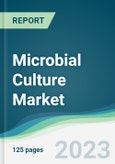The microbial culture market is estimated to grow at a CAGR of 6.24% during the forecast period.
A microbial culture, also referred to as microbiological culture, is a technique for growing microbial organisms in a controlled laboratory environment while allowing them to reproduce in a predefined culture media. In molecular biology, microbial cultures are fundamental diagnostic techniques employed as research tools. Some popular microbial cultures include broth cultures, agar plates, stab cultures, viral cultures, and eukaryotic cell cultures.Microbial cultures are one of the main microbiological diagnostic techniques used to identify infectious diseases' root causes and are also used in research in microbiology. Therefore the rising prevalence of infectious diseases such as COVID-19, SARS, dengue, malaria, and swine flu is driving the market's growth. Microbial cultures have also witnessed widespread application in the food and beverage industry. Microbiological cultures are used in fermented functional food and beverages. Growing consumer knowledge of physical fitness, including immunity-boosting foods in their daily diets, and the rising adoption of a healthy lifestyle will increase demand for microbial cultures and spur global market expansion. The growing application of microbial cultures in various end-user industries such as dairy, confectionary, beverages supplements, and nutraceuticals is also propelling the demand during the projection period.
However, the lack of knowledge regarding the health benefits of microbial cultures, particularly in emerging economies, strict rules and regulations regarding its use in the food and beverage industry, coupled with the growing incidence of allergies, is obstructing the growth of the global market for microbial cultures during the analysis period.
The rising demand for functional food and beverage products, along with the growing trend of biopreservation, is supporting the global microbial cultures market growth.
Microbial cultures are employed in the biopreservation of food products. The need for bio-preservation is rising due to consumer demand for essential safety standards in food items with an extended shelf life. Producers are focusing on natural ways to maintain their portfolios of dairy, beverage, and fresh bread items appealing for a longer time. Microbiological cultures are a crucial component of bio-preservation since consumers demand more clean-label products. Consumption of fermented functional food has significantly expanded in recent years due to its beneficial properties such as health advantages, improved shelf life, etc. Starter cultures are primarily used in the preparation of fermented foods. The well-researched starters cultures that manufacture many fermented foods, such as dairy, meat, sourdough, vegetables, etc., are lactic acid bacteria and yeast. The dairy culture markets are enjoying a boom in expansion and innovation in China, India, the rest of Asia, as well as the Middle East and African countries.North America is anticipated to hold a significant microbial culture market share during the forecast period.
North America is anticipated to hold a significant market share in microbial cultures. This region will witness high growth during the forecast period owing to the high prevalence of chronic diseases such as diabetes, hypertension, and heart diseases. Due to rising interest in health and well-being among consumers and rising demand for organic products, consumers in this region are demanding more and more products with different types of microbial cultures. Microbiological cultures are incredibly adaptable and can be used as functional food and beverage ingredients, additives, and supplement ingredients. This has boosted the growth of nutrients derived from microbial cultures in countries such as the United States and Canada. The high prevalence of key market players such as DuPont, Kerry, and Hansen Holding is also contributing to the region's growth. Due to consumers' increasing knowledge of the benefits of healthy and natural goods, the North American market is seeing strong development. The regional market expansion is anticipated to increase as more cultures are used in pharmaceutical and nutraceutical products.Market Developments:
- In January 2023, a study conducted at the University of Connecticut showed that protective bacterial cultures could be used to tackle food-borne pathogens resistant to antibiotics.
- In June 2022, a new technique for detecting accidental microbial contamination in mesenchymal stromal cell cultures was developed by researchers from the Critical Analytics For Manufacturing Personalized-Medicine interdisciplinary research group at the Singapore-MIT Alliance for Research and Technology, MIT's research enterprise in Singapore. This method enables quick and accurate testing of cell therapy products for patients. In contrast to less effective end-point testing, this ground-breaking technique uses machine learning to forecast whether a culture is clean or contaminated in almost real-time.
- In October 2021, Cherwell Labs, the maker of Redipor® prepared culture medium, announced the addition of ANT Medikal in Turkey to its global distribution network for the Redipor product line as part of its ongoing strategic focus on expanding its foreign markets.
Market Segmentation:
By Type
- Starter Cultures
- Adjunct and Aroma Cultures
- Probiotics
By End User
- Bakery and Confectionery
- Dairy
- Fruits and Vegetables
- Beverages
- Others
By Geography
- North America
- United States
- Canada
- Mexico
- South America
- Brazil
- Argentina
- Others
- Europe
- United Kingdom
- Germany
- France
- Spain
- Others
- Middle East and Africa
- Saudi Arabia
- UAE
- Israel
- Others
- Asia Pacific
- Japan
- China
- India
- South Korea
- Indonesia
- Thailand
- Others
Table of Contents
1. INTRODUCTION
2. RESEARCH METHODOLOGY
3. EXECUTIVE SUMMARY
4. MARKET DYNAMICS
5. GLOBAL MICROBIAL CULTURE MARKET BY TYPE
6. GLOBAL MICROBIAL CULTURE MARKET BY END-USER INDUSTRY
7. GLOBAL MICROBIAL CULTURE MARKET BY GEOGRAPHY
8. COMPETITIVE ENVIRONMENT AND ANALYSIS
9. COMPANY PROFILES
Companies Mentioned
- Chr. Hansen
- International Flavours and Fragrances
- DSM NV
- Mediterranea Biotecnologie SRL
- Himedia Laboratories
- Ingredion Incorporated
- Kerry Group
- Givaudan SA (Naturex)
- Dalton Biotecnologie S.r.l.
- Corbion
Methodology

LOADING...








